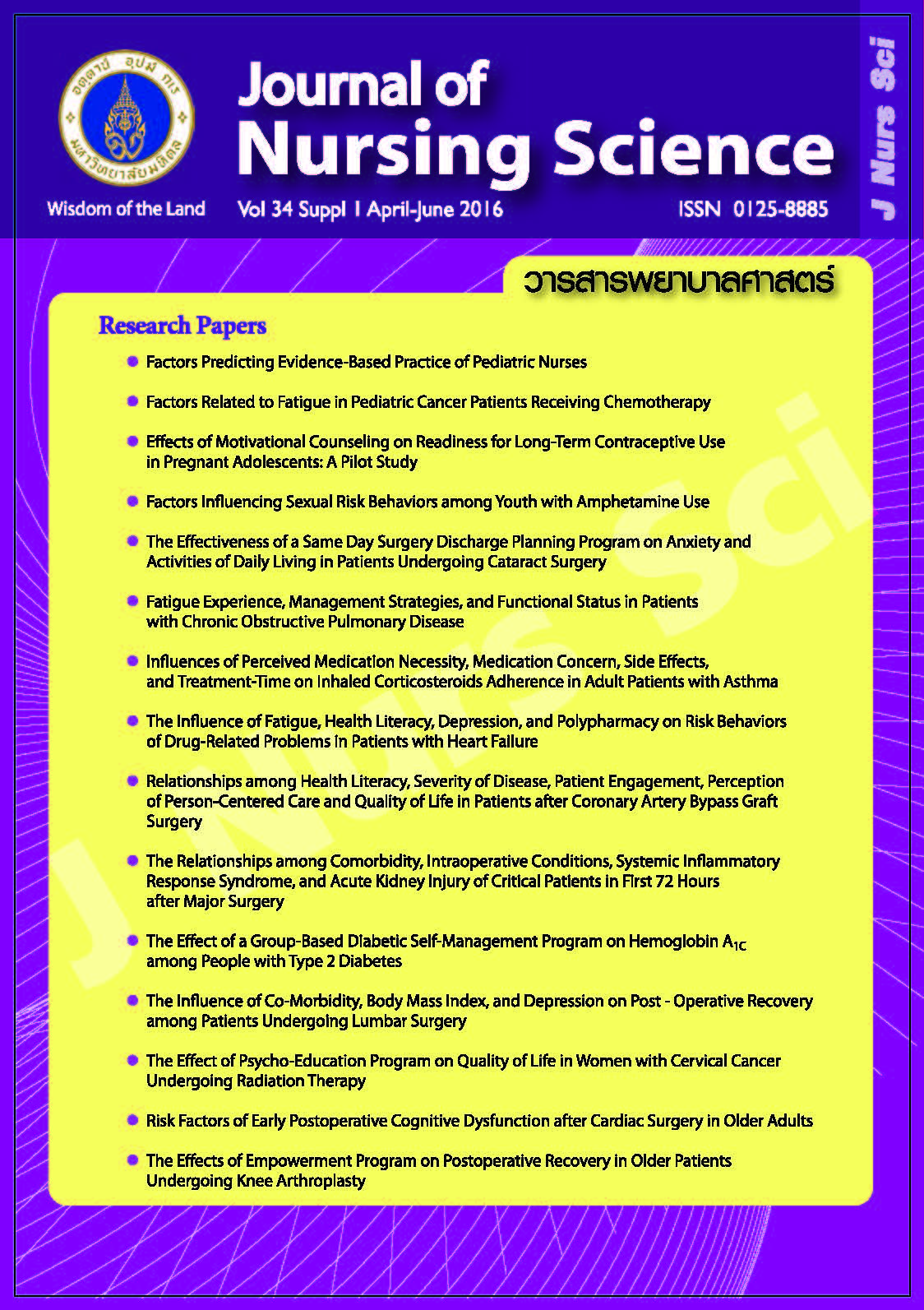The Influence of Co-Morbidity, Body Mass Index, and Depression on Post - Operative Recovery among Patients Undergoing Lumbar Surgery
Main Article Content
Abstract
Abstract
Purpose: This descriptive research aimed to study the influence of co-morbidity, body mass index, and depression on post-operative recovery among patients undergoing lumbar surgery.
Design: A correlational predictive study.
Methods: The sample comprised 100 patients who had undergone lumbar surgery and came for follow up visits at one University Hospital in Bangkok. The sample was selected according to the inclusion criteria. The instrument for data collection included a patients profile recording form,
Charlson Comorbidity Index, CES-D scale, and Clinical Symptom of Japanese Orthopaedic Association score (JOA score). Data were analyzed by descriptive statistics and multiple regression analysis.
Main findings: The findings showed that majority of patients were female (59%) with an average age of 56.50 years (SD = 15.23 years) and 72% had co-morbidity. The average score on the Charlson Comorbidity Index (CCI) was 1.61 (SD = 1.537, range = 0-8); the average body mass index was 25.51 kg/m2 (SD = 5.93 kg/m2). Fifteen percent of patients had depression with the average depression score of 12.24 (SD = 6.88) and the average score on Clinical Symptom of Japanese Orthopaedic Association score (JOA score) was 17.79 (SD = 5.06). Co-morbidity, body mass index, and depression could explain the variance of post-operative recovery by 30.4% (R2 = .304, F = 13.989, p < .05) while depression and co-morbidity could significantly predict post-operative recovery (β = - .420, and β = - .308, p < .05 respectively).
Conclusion and recommendations: In preoperative phase of lumbar surgery, patients should be routinely assessed on their co-morbidity, body mass index and depression. The guideline that follows the post-operative recovery level using JOA score should be implemented among patients who had co-morbidity and depression. For the patients who show depressive symptoms at the preoperative phase, appropriate measures should be employed to facilitate smooth and healthy transition so that the patients can achieve full recovery.
อิทธิพลของโรคร่วม ดัชนีมวลกาย และภาวะซึมเศร้า ต่อการฟื้นตัวหลังผ่าตัดในผู้ป่วยที่ได้รับการผ่าตัดกระดูกสันหลังระดับเอว
บทคัดย่อ
วัตถุประสงค์: เพื่อศึกษาอำนาจการทำนายของโรคร่วม ดัชนีมวลกาย และภาวะซึมเศร้า ต่อการฟื้นตัวหลังผ่าตัดในผู้ป่วยที่ได้รับการผ่าตัดกระดูกสันหลังระดับเอว
รูปแบบการวิจัย: การศึกษาความสัมพันธ์เชิงทำนาย
วิธีดำเนินการวิจัย: กลุ่มตัวอย่างเป็นผู้ป่วยหลังผ่าตัดกระดูกสันหลังระดับเอว จำนวน 100 คน ที่มาติดตามการรักษาหลังผ่าตัดกระดูกสันหลังระดับเอวที่โรงพยาบาลมหาวิทยาลัยแห่งหนึ่งในกรุงเทพมหานคร ใช้วิธีเลือกกลุ่มตัวอย่างตามเกณฑ์ที่กำหนด เก็บข้อมูลโดยใช้แบบสอบถามข้อมูลส่วนบุคคล ข้อมูลเกี่ยวกับความเจ็บป่วยและการรักษาที่ได้รับแบบประเมินโรคร่วม แบบประเมินภาวะซึมเศร้า และแบบประเมินการฟื้นตัวหลังผ่าตัด วิเคราะห์ข้อมูลโดยใช้สถิติเชิงพรรณนา และการวิเคราะห์อำนาจการทำนายโดยใช้สถิติวิเคราะห์ถดถอยพหุคูณ
ผลการวิจัย: กลุ่มตัวอย่างส่วนใหญ่เป็นเพศหญิง (ร้อยละ 59) มีอายุเฉลี่ย 56.50 ปี (SD = 15.23 ปี) มีโรคร่วมสูงถึงร้อยละ 72 ค่าดัชนีมวลกายเฉลี่ยเท่ากับ 25.51 (SD = 5.93) มีภาวะซึมเศร้าร้อยละ 15 โดยมีคะแนนเฉลี่ยของภาวะซึมเศร้าเท่ากับ 12.24 คะแนน (SD = 6.88) คะแนนเฉลี่ยในการฟื้นตัวหลังผ่าตัดกระดูกสันหลังระดับเอวเท่ากับ 17.79 คะแนน (SD = 5.06) โรคร่วม ดัชนีมวลกาย และภาวะซึมเศร้า สามารถร่วมกันทำนายการฟื้นตัวหลังผ่าตัด เมื่อมาติดตามผลลัพธ์การรักษาภายใน 3 เดือนหลังผ่าตัดได้ร้อยละ 30.4 (R2 = .304, F = 13.989, p < .05) โดยพบว่า ภาวะซึมเศร้าและโรคร่วมสามารถทำนายการฟื้นตัวหลังผ่าตัดได้อย่างมีนัยสำคัญ (β = - .420, และ β = - .308, p < .05 ตามลำดับ)
สรุปและข้อเสนอแนะ: พยาบาลและบุคลากรทางสุขภาพควรคัดกรองภาวะโรคร่วม ตรวจสอบดัชนีมวลกาย และภาวะซึมเศร้าก่อนการผ่าตัด และพัฒนาโปรแกรมในการติดตามประเมินระดับการฟื้นตัวของผู้ป่วยที่มีโรคร่วมและมีภาวะซึมเศร้า ร่วมกับการจัดการแก้ปัญหาภาวะซึมเศร้าของผู้ป่วยก่อนการผ่าตัด เพื่อส่งเสริมให้ผู้ป่วยหลังผ่าตัดกระดูกสันหลังระดับเอวมีการเปลี่ยนผ่านสู่ภาวะสุขภาพที่ดีและเกิดการฟื้นตัวได้อย่างราบรื่น
คำสำคัญ: โรคร่วม ดัชนีมวลกาย ภาวะซึมเศร้า การฟื้นตัวหลังผ่าตัด การผ่าตัดกระดูกสันหลังระดับเอว
Article Details
Copyright Notice: Nursing Science Journal of Thailand has exclusive rights to publish and distribute the manuscript and all contents therein. Without the journal’s permission, the dissemination of the manuscript in another journal or online, and the reproduction of the manuscript for non-educational purpose are prohibited.

Disclaimer: The opinion expressed and figures provided in this journal, NSJT, are the sole responsibility of the authors. The editorial board bears no responsibility in this regard.


